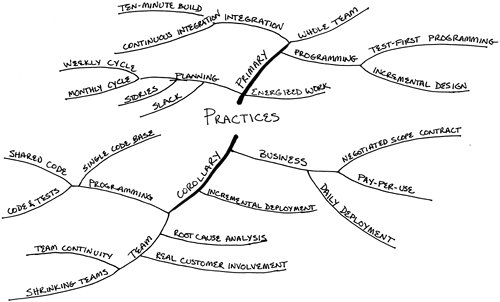Following are the practices of XP, the kind of things you'll see XP teams doing day-to-day. Practices by themselves are barren. Unless given purpose by values, they become rote. Pair programming, for example, makes no sense as a “thing to do to check off a box”. Pairing to please your boss is just frustrating. Pair programming to communicate, get feedback, simplify the system, catch errors, and bolster your courage makes a lot of sense.
Practices are situation dependent. If the situation changes, you choose different practices to meet those conditions. Your values do not have to change in order to adapt to a new situation. Some new principles may be called when you change domains.
The practices are stated as absolutes. My intention is to motivate you to aim for perfection, provide you with clear goals, and give you practical ways to get there. The practices are a vector from where you are to where you can be with XP. In XP, you make progress towards this ideal state of effective development. For example, daily deployment may make no sense if you only deploy once a year. Successfully deploying more frequently is an improvement, building confidence for the next step.
Applying a practice is a choice. I think the practices make programming more effective. This is a collection of practices that work and work even better together. They have been used before. Experiment with XP using these practices as your hypotheses. For example, let's try deploying more frequently and see if that helps.
The XP practices do not represent some kind of pinnacle in the evolution of software development. They are a common way station on the road to improvement. The XP practices tend to work well together. Taken one at a time you will likely see improvement. When they begin to compound you may see dramatic improvement. The interactions between the practices amplify their effect.
I have divided the practices into two chapters: “Primary Practices,” Chapter 7, and “Corollary Practices,” Chapter 9. The primary practices are useful independent of what else you are doing. They each can give you immediate improvement. You can start safely with any of them. The corollary practices are likely to be difficult without first mastering the primary practices. The amplification effect of using the practices together means there is an advantage to adding practices as quickly as you can.
Figure 3 is a summary of the practices:

